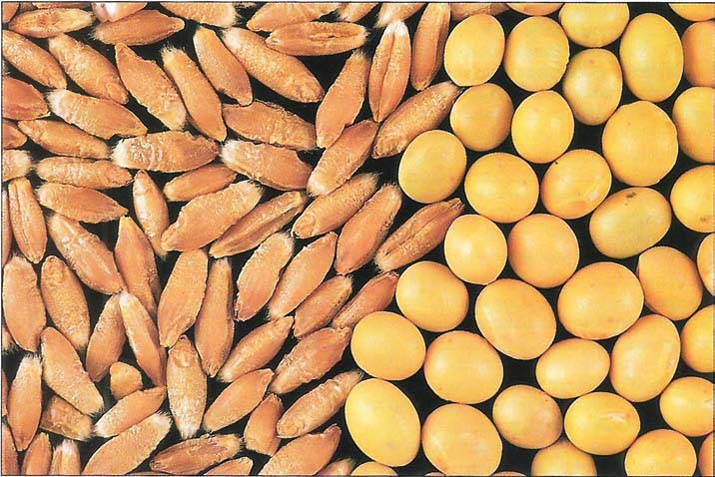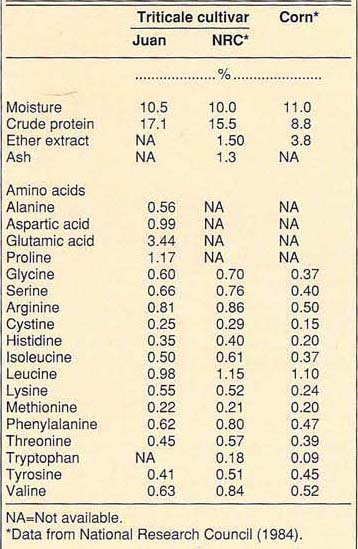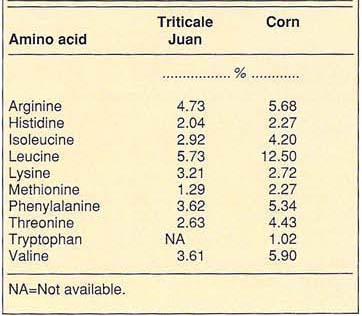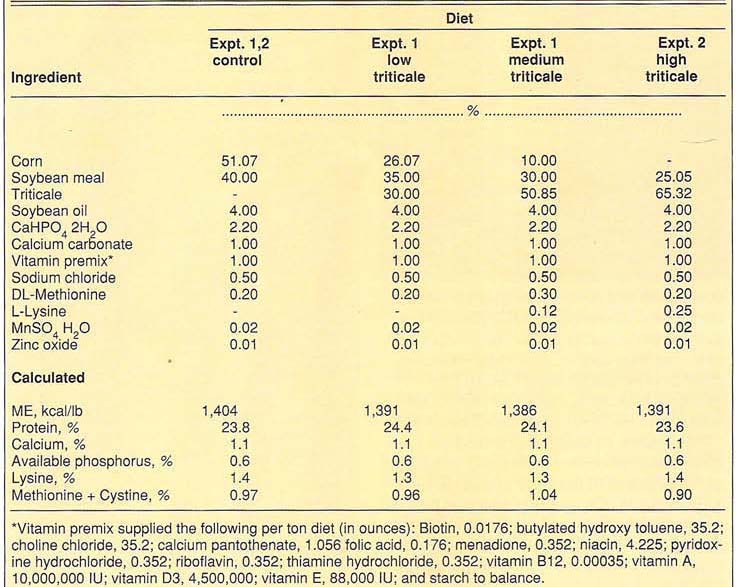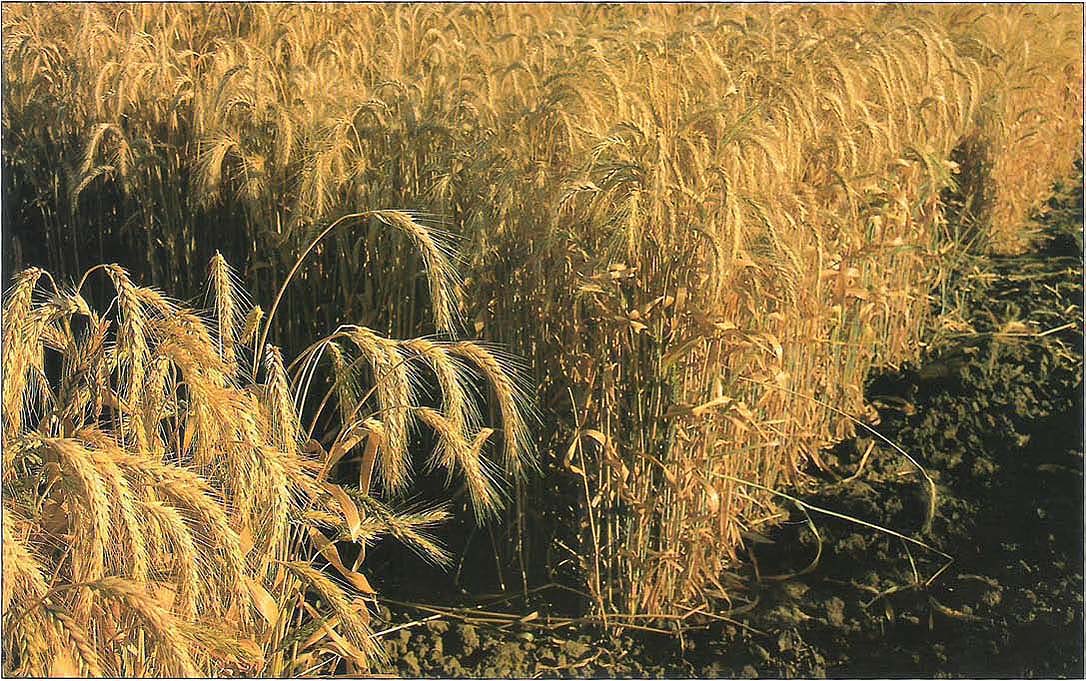All Issues
Triticale: an alternative cereal grain in broiler starter diets
Publication Information
California Agriculture 45(5):34-37.
Published September 01, 1991
PDF | Citation | Permissions
Abstract
California poultry diets typically contain about 60% corn and 30% soybean meal even though the bulk of these ingredients have to be transported from the Midwest. Triticale is a viable alternative feedstuff for poultry because it has a substantially higher protein content than corn and reduces the amount of soybean meal needed in poultry diets. This potential California crop could save the industry a substantial portion of its current shipments of Midwest corn and soybean meal.
Full text
Triticale (left) has higher protein content than corn, making it a viable alternative for poultry diets. Soybeans (right) are another protein source in poultry diets.
Triticale (X Triticosecale Wittmack) is a synthetic hybrid of wheat and rye that has been under intensive development as a new cereal grain crop plant for about 25 years. Initially, triticale suffered from poor kernel development, but genetic improvements in kernel size and development and other agronomic improvements have made triticale an important crop in some areas. For example, total production area in Australia, France, Poland, and the U.S.S.R. was about 395,000 acres in 1986 when the world total was estimated at 3,029,000 acres. U.S. triticale production is about 250,000 acres, but with improved cultivars becoming available, it is an attractive alternative crop for which grain yields often exceed those of wheat and barley.
What is needed are clearly defined markets and end-users for this new grain. Triticale is presently used in a minor way in baked products for human consumption, but its main entre' to the U.S. agricultural scene will no doubt be its establishment as a superior ingredient in animal diets. A recent National Research Council report shows that triticale is poised as an important food crop plant for marginal crop-producing environments.
Triticale in poultry diets
Poultry diets for meat and egg production typically contain about 60% corn and about 30% soybean meal. Corn contains less than 9% crude protein, so substitution by a cereal grain with a higher protein content will reduce the amount of soybean meal needed in poultry diets. The protein content of triticales ranges from 11.8% to 22.5% and generally is higher than that of wheat and corn. Based on data available in the early 1970s, there is a great potential for triticale use in poultry diets.
Broiler diets
Wheat, rather than corn, is the main cereal in poultry diets in many countries. A number of reports are available on the use of triticales to substitute for wheat in diets of broiler chicks. Studies from Canada in 1962 indicated that triticales varying in protein content from 16% to 18.3% were as good as hard red wheat in supporting growth of broilers.
In a 1970 report, researchers found that replacing wheat partially or completely with triticale had no adverse effects. In 1975, British workers found triticale to be superior to wheat when incorporated into broiler diets at levels of 30% to 50%. In the same year, workers in India substituted corn with triticales in diets containing peanut meal without any difference in growth of broilers. Triticale cultivar 72-S was found to be better than cultivar 131 in replacing corn in broiler diets in India in 1976 and 1979.
In Washington state, results published in 1985 showed that broiler growth was improved if diets containing triticale (grown at Washtucna or at Washington State University) at levels of 62.5% were supplemented with penicillin and hemicellulase. No differences in body weights were observed for chicks fed over the first 21 days either a diet containing 64% triticale or corn and 29% soybean meal in feeding trials conducted in France in 1985. However, in a 1987 Florida study triticale cultivar Beagle 82 — included as 25% to 58% of the diet fed to broiler chicks from the age of 1 to 21 days — caused small inconsistencies in growth response.
Egg production
Laying hens fed diets containing 85% triticale produced as many eggs of the same size as those fed the corn-based conventional diets in Mexico in 1973. This was confirmed at Washington State University in 1985.
Nutrient composition
Digestibility of nutrients in triticale having a crude protein content of 13.8% was found to be superior to wheat in studies in Britain when fed at a dietary level of 88% to laying hens. Metabolizable energy of triticale has been a topic of reports from many countries, and ranges from 1,394 kcal to 1,562 kcal/lb dry matter. True metabolizable energy ranges from 1,598 kcal to 1,654 kcal/lb dry matter, with a mean value of 1,625 kcal/lb according to workers in Washington State University. True metabolizable energy is about 1.1 times higher than apparent metabolizable energy, so the value for the latter would be 1,480 kcal/lb. Triticale was already accepted as an important feed ingredient for inclusion in the 1984 U.S. National Research Council publication Nutrient Requirements of Poultry and values of 1,436 kcal/lb or for metabolizable energy, and 15.8% for crude protein, were assigned. Table 1 presents findings on nutrient composition of Juan triticale grown in California in 1986 and compares it with data published by National Research Council for a composite triticale and for corn.
Japanese quail: research model
In 1975, UC Davis studies compared diets containing five triticale cultivars to a corn-based control diet for their ability to support growth and egg production in Japanese quail. Triticale cultivars were Cinnamon, PM-59, PM-132, 6TA-204, Ar-madillo-107, and Armadillo-116. In later studies, triticale cultivars Mapache and 6TA-204 proved better than wheat cultivars if used as the sole source of protein in diets of quail or chickens.
New cultivars of triticale being developed for improved grain yields and kernel characteristics will quite likely vary in their inherent nutritional qualities. Juan is a recent cultivar originating from a family of triticales known as Juanillo developed at the International Maize and Wheat Improvement Center (CMMYT) in Mexico. It was released by the California Agricultural Experiment Station in 1984.
Experiments with Juan triticale
The Juan triticale grain used in this study was produced at UC Davis in a foundation seed field in 1986. Commercial production practices were used, including nitrogen fertilization at about 80 lb N per acre. The crop was fall-planted and irrigated at the jointing and heading stages. The productivity of the 10-acre field was about 6700 lb/ac. The seed used in the feeding trial had been cleaned and processed in the usual way for preparing seed for planting.
The composition of Juan triticale was determined following the standard Association of Official Analytical Chemists methods. Protein concentration was calculated by multiplying Kjeldahl nitrogen concentration by 6.25. Amino acids were determined by ion-exchange chromatography after acid hydrolysis of the sample.
Tryptophan is lost in hydrolysis and a separate analysis was not done to determine its concentration. Juan had a substantially higher protein concentration than corn. Table 2 shows a comparison of the essential amino acid concentrations based on the percentage of total protein of triticale and corn. Triticale protein has about twofold greater lysine, whereas methionine plus cystine content was lower than in corn protein.
Design of feeding trials
Broiler chickens are generally fed a starter diet, followed by grower and finisher diets, before they are marketed at about 7 weeks of age. If a feedstuff is found satisfactory in the starting diets, it is usually usable in growing and finishing diets. As the birds increase in weight, their feed consumption increases tremendously. Research nutritionists generally evaluate feedstuffs on the basis of gain in body weights over about a 3-week growth period because of budget and space constraints. These constraints also restrict the number of birds that can be included in experiments.
Two feeding experiments were done beginning with day-old Hubbard broiler-type chicks. Table 3 shows the composition of the diets used in these experiments. In experiment 1, two diets containing about 30% (low-triticale diet), and about 50% (medium-triticale diet) triticale were compared to a corn-soybean meal control diet. The diets were fed to duplicate groups of six chicks each. The level of triticale was increased to 65% (high-triticale diet) in experiment 2, and fed to four groups of six birds each. The control diet was fed to two groups of seven birds each.
As shown in table 3, triticale diets were formulated to contain about the same level of nutrients as in the control diet. In the high-triticale diet, protein was supplied only by a combination of triticale and soybean meal. This diet had the lowest soybean meal content of the three diets studied. In both experiments, the chicks were fed for 21 days. The chicks were maintained in battery cages in a room kept at a constant temperature of about 75° + 2°F. Feed and water were available at all times. Day-old chickens were weighed at the start of the experiment, and twice weekly during the experiment. The total amount of feed consumed was also measured to calculate the efficiency of conversion of feed into body mass.
The mean gain in body weight per bird was subjected to analysis of variance to test for statistically significant (P<0.05) differences among the diets.
Results: growth of broilers
Experiment 1
Mean cumulative body weight gains of broiler chicks fed low-triticale, medium-triticale, and corn control diets are given in table 4. No statistically significant differences in mean body weight gain were observed on any dietary treatment on any day of weighing.
Experiment 2
All the corn in the high-triticale (65%, experiment 2) diet was replaced by triticale, which also reduced the required amount of soybean meal to 25% of the diet. Table 5 shows the mean gain in body weight of broiler chicks in experiment 2. In contrast to experiment 1, the mean gain in body weight of broiler chicks fed the high-triticale diet was significantly inferior to that fed the corn-soybean control diet. Because the diet was designed to meet nutrient requirements for chicks, these results suggest that the chemically determined amino acid profile of triticale does not represent the biological availability of the essential amino acids.
TABLE 2. Essential amino acids in triticale and corn as a percentage of total protein calculated from data in table 1
In 1986, Australian researchers had already reported that digestibility of lysine in triticale was reduced by an increase in acid detergent fiber in triticale, but not by an antinutrient such as antitrypsin. No ergot or other antinutrient has been reported in triticale grown in California. A combination of 65% triticale and 25% soybean meal did not meet the nutrient requirement of chickens for optimal growth in the present study. On the other hand, if the level of triticale was decreased from 65 to 50%, the soybean meal increased from 25 to 30%, and 10% corn was added (as in Experiment 1, medium-triticale trial), the diet promoted chick growth as well as the control diet. Workers in Florida reported a similar observation of poorer growth of broilers when corn was excluded in diets containing 33% soybean meal and 58% Beagle triticale. However, if they reduced the level of triticale in the diet to 50% and increased the soybean meal to 37%, the results were as good as with the corn-soybean meal diet.
Feed conversion ratios
The estimated feed conversions or the amount of feed (in pounds) required per pound of gain in body weight are given in tables 4 and 5. Because the feed consumption was not estimated on individual birds, only mean values for the two groups for feed conversion ratio are reported. No statistically significant differences in the feed conversion among the diets were observed. Because the feed conversion ratios are of the same order for the different dietary treatments, we suggest that Juan triticale is a suitable feed ingredient for use in broiler diets. In 1989, University of Georgia workers reported similar results in their triticale studies.
Triticale's potential value
We conclude that Juan triticale is very suitable in broiler diets at levels as high as 50% along with 10% corn. This reduces the required level of soybean meal to about 30%. To illustrate the potential economic value of Juan triticale in broiler diets, we made the following analysis.
Assume a price of $4.50 for 100 lb corn and $9.54 for 100 lb soybean meal, and that metabolizable energy (ME) in corn and soybean meal are 1.523 and 1.109 megacalories per pound (Mcal/lb), respectively. Also assume that corn and soybean meal are 8.8 and 48.5% protein, respectively. If X represents the price/Mcal/lb ME and Y the price in cents/lb protein, then
For corn
152.3 X + 8.8 Y = 450 cents (1)X = (450 cents - 8.8 Y)/152.3 = 2.955 cents - 0.0578 Y (2)For soybean meal
110.9 X +48.5 Y = 954 cents (3)Y = (954 cents -110.9 X)/48.5 = 19.67 cents - 2.287 X (4)Substituting (2) in (4)
Y = 19.67 cents - 2.287 (2.955 cents 0.0578Y) = 19.67 cents - 6.758 cents + 0.132 Y = 14.876 cents Therefore X = 2.095 centsBecause Juan triticale contains 17.1% protein and 1.445 Mcal/lb ME, its economic value is
144.5 X + 17.1 Y = 144.5 x 2.095 cents + 17.1 x 14.876 cents = 557 cents or $5.57/100 lbThis implies that on the basis of its metabolizable energy, protein content, and the prices used in this illustration, Juan triticale is a better buy than corn. Triticale would be worth substituting for corn selling at $4.50/100 lb even if its protein content were as low as 10% when its economic value would still be $4.73/100 lb. Of course, feed prices vary and this analysis illustrates the approach to be taken when considering the inclusion of triticale into poultry diets. For the circumstances of this research, triticale. appears to be a viable alternative on both nutritional and economic grounds as a poultry feed ingredient.
Triticale's potential in California
In general, poultry diets, even in California where soybean is not grown, contain about 60% corn and 30% soybean meal despite the fact that the bulk of these ingredients have to be transported from the Midwest. Corn contains less than 9% crude protein. Triticale, which has a higher protein content, can be substituted for corn. This helps to reduce the levels of corn as well as soybean meal in poultry diets.
California produced about 222 million broilers in 1989 or about 1,045 million pounds utilizing 1.05 million tons of feed. Triticale could replace 10% of the soybean meal and 41% of the corn in broiler diets, or a total of about 0.5 million tons.
In 1989, California produced 7,718 million eggs from 33.3 million hens. A hen consumes about 120 lb of feed over a 70-week period. The California egg production industry uses about 2 million tons of feed containing about 65% corn and 23% soybean meal each year. One million tons of triticale at a level of 50% in the diet could be used in layer diets. Thus, there is a potential market for about 1.5 million tons triticale for the poultry industry in California.
TABLE 5. Growth and feed conversion ratios of broiler fed control and triticale diet (experiment 2) over three observation periods
For locally produced triticale this would represent the production from 0.75 to 1.0 million acres. Therefore, the poultry industry could save the cost of shipment of an equivalent amount of ingredients from the Midwest. We have confirmed triticale's potential for reducing levels of corn and soybean meal in the diets of broiler chickens, and in supporting early growth of broiler chicks.
P. Vohra is Professor Emeritus and S. Bersch was Postgraduate Research Scientist, Department of Avian Sciences, and C. O. Qualset is Professor, Agronomy and Range Science, all at UC Davis..



